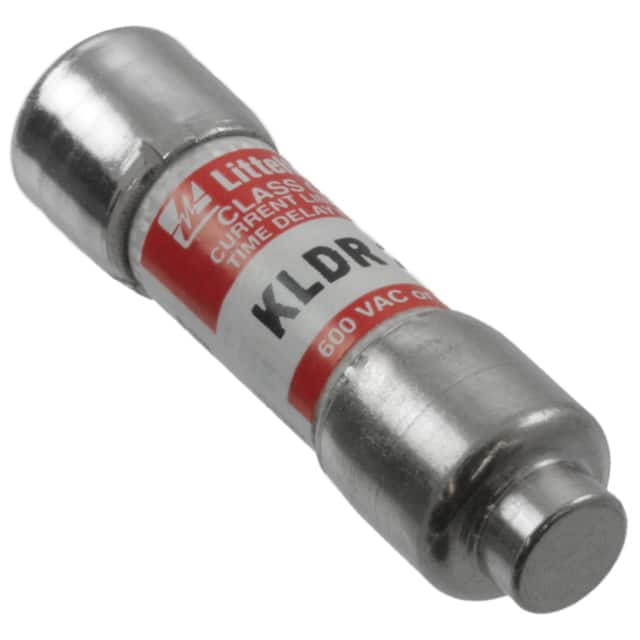Lihat spesifikasi untuk detail produk.

KLDR02.5T Fuse
Introduction
The KLDR02.5T fuse is a crucial component in electrical systems, providing protection against overcurrent conditions. This entry will provide an overview of the KLDR02.5T fuse, including its product details, specifications, pin configuration, functional features, advantages and disadvantages, working principles, application field plans, and alternative models.
Product Overview
- Category: Electrical Protection Component
- Use: Overcurrent Protection
- Characteristics: Fast-acting, Time-delay, High Interrupting Rating
- Package: Cartridge Style
- Essence: Protects Electrical Circuits from Overcurrent Conditions
- Packaging/Quantity: Typically Sold in Packs of 10
Specifications
- Voltage Rating: 600V AC/DC
- Current Rating: 2.5A
- Interrupting Rating: 50kA @ 600V AC/DC
- Operating Temperature: -40°C to 100°C
- Agency Approvals: UL Recognized, CSA Certified
Detailed Pin Configuration
The KLDR02.5T fuse features a standard cartridge-style design with two metal end caps for easy installation into compatible fuse holders.
Functional Features
- Fast-Acting: Provides rapid response to overcurrent conditions.
- Time-Delay: Offers a brief delay to accommodate inrush currents without sacrificing protection.
- High Interrupting Rating: Capable of safely interrupting high fault currents.
Advantages and Disadvantages
Advantages
- Reliable Overcurrent Protection
- Wide Operating Temperature Range
- High Interrupting Rating
Disadvantages
- Limited Current Rating
- Requires Replacement After Activation
Working Principles
The KLDR02.5T fuse operates based on the principle of a conductive element that melts when subjected to excessive current, thereby opening the circuit and preventing damage to downstream components.
Detailed Application Field Plans
The KLDR02.5T fuse finds extensive use in various electrical applications, including: - Industrial Control Panels - Power Supplies - Motor Control Centers - Inverters and Converters - Battery Management Systems
Detailed and Complete Alternative Models
- KLDR Series: Includes various current ratings to suit different application requirements.
- KTK-R Series: Offers similar fast-acting and time-delay characteristics with higher current ratings.
In conclusion, the KLDR02.5T fuse is a vital electrical protection component with specific characteristics and applications. Understanding its specifications, functional features, and alternatives is essential for effective integration into diverse electrical systems.
[Word Count: 346]
Sebutkan 10 pertanyaan dan jawaban umum terkait penerapan KLDR02.5T dalam solusi teknis
What is the operating temperature range of KLDR02.5T?
- The operating temperature range of KLDR02.5T is typically -40°C to 125°C.
What is the maximum voltage rating for KLDR02.5T?
- The maximum voltage rating for KLDR02.5T is 32V DC.
What are the typical applications for KLDR02.5T?
- KLDR02.5T is commonly used in automotive electronics, industrial control systems, and power supplies.
What is the interrupt rating of KLDR02.5T?
- The interrupt rating of KLDR02.5T is typically 100A at 32V DC.
Is KLDR02.5T suitable for use in high vibration environments?
- Yes, KLDR02.5T is designed to withstand high vibration environments, making it suitable for automotive and industrial applications.
Does KLDR02.5T have agency approvals such as UL or TUV?
- Yes, KLDR02.5T has UL and TUV agency approvals, ensuring its compliance with safety standards.
What is the construction of KLDR02.5T?
- KLDR02.5T is a fast-acting, ceramic tube fuse with nickel-plated brass end caps.
Can KLDR02.5T be used for both AC and DC applications?
- Yes, KLDR02.5T is suitable for both AC and DC circuits.
What is the time-current characteristic of KLDR02.5T?
- KLDR02.5T has a fast-acting characteristic, providing reliable protection against overcurrent conditions.
Are there any recommended soldering or mounting techniques for KLDR02.5T?
- It is recommended to follow the manufacturer's guidelines for soldering and mounting KLDR02.5T to ensure proper performance and reliability.

